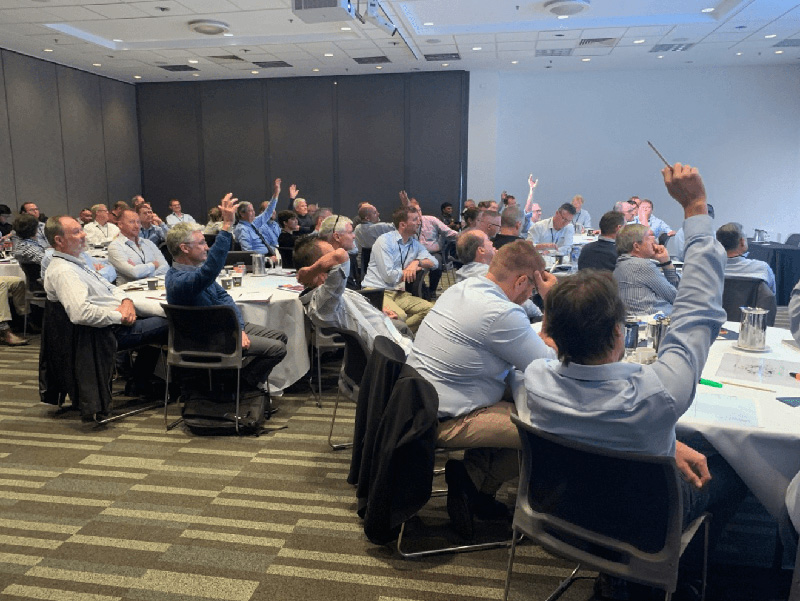On May 21, Dr Penny Stewart Managing Director of PETRA Data Science co-hosted the Austmine Machine Learning Workshop in Brisbane along with METS Ignited and the Australian Institute for Machine Learning. The aim was to help participants identify the role of machine learning in their businesses. So how did the conversation come around to whether machine learning can predict tailings dam failures?
Stewart explains: “I gave workshop attendees a business case evaluation exercise. There were 8-10 people at a table, and each group came up with ideas for potential machine-learning applications. They ranked these based on technical risk, and on value proposition.”
“Each group provided their top priority, and then the participants (eight or nine groups) voted for the one they thought had the most value; that was tailings dam monitoring (see table). “
Participants top applications for ML (ranked by number of votes)
1. Predicting failure of tailings dams
2. Rock mass characterisation
3. Conveyor idler failure
4. Controlling drill rig maintenance and consumable costs
5. Exploration targeting
6. GET detachment
7. Modelling materials handling and transfer chutes at ports
8. Intelligent load shedding from power instability
9. Integrated coal and power efficiency

Tailings in the spotlight
The outcome isn’t surprising given the exposure that tailings storage facilities (TSFs) have received in the media recently.
The ICMM, UN Environment Programme and Principles for Responsible Investment, have co-commissioned a review to develop an international standard for the safe management of tailings storage facilities.
Part of this is likely to involve the evaluation and stipulation of minimum requirements for monitoring technologies and practices. A draft of the standard is expected in August 2019, but until then it is prudent for mines to conduct their own technology assessments.
How could machine learning be applied in this context?
Stewart is pragmatic: “There are different types of data that you get from monitoring tailings dams, including; hydraulic pressures, displacement data and visual imaging from satellites.
“I expect data platforms capable of near real-time integration of all monitoring data will enable more complete and complex monitoring of tailings dams, including potentially machine learning.
“That said, I don’t know if this would be enough to accurately predict or prevent a failure. Tailings dams can fail very suddenly, and with little warning, particularly if liquefaction of the tailings is triggered.
“While drainage is designed to control the phreatic surface in the tailings dam to maintain stability, they can malfunction and fail, and piezometers may not be sufficient to detect this. Perhaps UAV geophysics has a role in enabling AI to detect anomalies in the hydraulic operation of tailings dams?”
Invest in collaboration
Stewart is not alone in wondering how technology could address this cause. Mine software expert Maptek, and TRE Altamira, which specialises in geospatial monitoring using satellite-based radar technology, have also been debating its value.
Maptek’s Sentry system combines a laser scanner with software to monitor and report on ground movements that have the potential to cause dam failures. Product manager, James Howarth, is optimistic about the integration of AI.
“We believe there is good potential for using machine learning to assist in interpreting data from laser scanning for dam failure predictions,” he says. “With possibilities of learning patterns from previous data that can be used to identify areas of change and warn of impending failures.”
Maptek CEO, Peter Johnson, agrees but adds that a holistic approach to dam monitoring is important; machine learning alone will not solve this challenge.
“The best overall outcome for the industry will be achieved by working collaboratively and combining the various techniques and technologies being developed to solve this problem,” he explains.
“A combination of spatial measurement and monitoring, physical sensors, image analysis, machine learning and data science will allow the industry to extract the best value from all relevant data relating to TSF condition monitoring.
“Maptek would be supportive of the establishment of a consortium of solutions providers being supported by industry to deliver on this potential.”
The sky is not the limit
While Maptek’s system relies on data from terrestrial devices, TRE Altamira’s platform harnesses interferometric synthetic-aperture radar (InSAR) imagery generated by satellites.
CEO, Alessandro Ferretti, tells PETRA: “The demand for new, satellite-based, monitoring solutions has increased steadily over the year, as well as the number satellite data sources available for commercial projects.
“Satellite radar data for surface deformation monitoring are becoming a must-have for the mining industry.”
Jessica Morgan, technical sales representative, and country manager for Australia and New Zealand, adds: “Machine learning is a potential factor in the search for approaches on dam failure prediction, as nowadays the definition of a warning signal mostly depends on fixed threshold and rigid data screening.
“Every mine and tailings dam should have triggers and alarms tailored to the specific characteristics of that site. The main struggle will be upscaling simplistic models (or thresholds) to a wide and varied range of locations.
“Machine learning may be used to overcome such limitations, provided robust data are part of an integrated monitoring approach.”
Descartes Labs is also reportedly investigating how different geospatial datasets can be combined and applied in TSF monitoring. The company’s platform is expected to incorporate data from different sources and model it in a single environment, allowing predictions to be made using machine learning.
Descartes will allegedly make the results of its work public in a few months and, if the project is a success, this could provide a leg-up for other AI-based initiatives too.
In response to the question posed at the start of this article: can machine learning predict tailings dam failures? The answer is currently no; not reliably. However, that may soon change.
